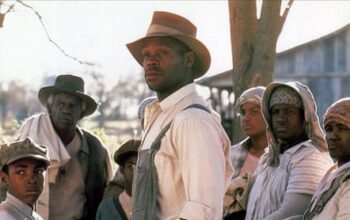Cinema has a troubled relationship with the Holocaust. It is repeatedly drawn to the subject, which seems to offer a shortcut to moral gravity, emotional depth and the highest possible stakes – elements every storyteller yearns for – and yet there is so much that can go wrong.
One potential issue with portraying the Nazi genocide of 6 million Jews is that it may downplay the severity of the event. For instance, even if an actor were to undergo an extreme diet, they could never truly replicate the emaciated appearance of the Muselmänner – the skeletal inmates who filled the concentration camps. Ultimately, any depiction on screen will pale in comparison to the true horrors of the situation.
The tendency to focus on the survivors rather than the victims is a common one, which may explain the mixed reactions to Schindler’s List, the most well-known film about the Holocaust. Even famed director Stanley Kubrick was inspired to abandon his own project after Spielberg’s film gained recognition. Kubrick stated that Schindler’s List was more of a success story than a portrayal of the genocide itself, with only a small portion of the 6 million victims being highlighted.

However, any movie that accurately portrays the core of those occurrences – that boldly gazes into the unknown – runs the risk of being unpleasant or even unviewable. This, combined with the concern that as the last remaining survivors pass away and the Holocaust becomes a distant memory in history, public interest would diminish, led many to believe that film would gradually shift its focus. Yet, this belief was proven wrong as evidenced by a new set of three films, indicating that cinema cannot resist delving into this subject.
Those movies could not be more different. They share a tacit belief that the Shoah remains humanity’s ultimate moral test case, one that reveals the extent of our capacity for evil and the resonance and relevance of which only increases the further away it gets. Besides that, each film finds its own way to wrestle with – or avoid – the quandaries inherent in putting the Holocaust on screen.
The primary undertaking is One Life, directed by James Hawes and featuring Anthony Hopkins in the role of Nicholas Winton. Winton, a stockbroker from London, along with his mother portrayed by Helena Bonham Carter, and a small group of individuals, took on an unofficial rescue mission to bring 669 children, primarily Jewish, from Prague to Britain. The film focuses on the time just before the start of World War II, with Johnny Flynn as the young Winton, and also on Winton’s later years in retirement. This approach avoids the challenge of depicting historical events. The film does not include scenes of Auschwitz or gas chambers, as these are only depicted in the minds of the audience and in Winton’s own reflections on the children he was unable to save.
This is one of many parallels to Schindler’s List. Both movies focus on individuals who saved others, but never sought recognition for their actions. Instead, they were tormented by those they were unable to save. In the final moments of Spielberg’s film, Schindler (played by Liam Neeson) laments, “I could have saved more…I didn’t do enough.” Similarly, an older Winton is seen flipping through a photo album, fixated on the faces of those he was unable to rescue.

Similar to Schindler’s List, One Life concludes with a poignant and emotional ending. In a similar fashion, Spielberg includes real-life footage of survivors and their descendants, highlighting the impact of Schindler’s actions. The highlight of One Life is a re-enactment of a 1988 episode of the BBC TV show That’s Life!, where Esther Rantzen surprises Nicholas Winton by having all the people who owe their lives to him stand up in the studio audience. The film serves as a prelude to this touching moment. As Kubrick suggested, the only Holocaust film worth watching is one that focuses on the survivors and those who aided them, rather than the deceased.
Many Holocaust films are missing active and complex Jewish characters. Instead, they often portray Jews as passive victims in need of a non-Jewish savior. While One Life does acknowledge the Jewish heritage of the Winton family, the children are primarily depicted as generic European refugees without much explanation as to why they cannot stay in Czechoslovakia. The film’s trailer also fails to mention the word “Jewish”.
This could be due to the tendency, seen in many Holocaust commemorations, to portray it as a universal occurrence of cruelty between humans rather than a targeted effort, influenced by centuries of anti-Semitism, to eliminate Jews from existence. It may also stem from a well-established discomfort within Hollywood when it comes to Jewish narratives – a discomfort that is not diminished by the fact that many Jewish writers and producers are responsible for trying to appeal to a wider audience. (For example, a Jewish NBC executive who cautiously approved the unusually short first season of Seinfeld after initially deeming it “too New York, too Jewish.”)
The absence of Jews is a central and deliberate aspect in some of the unsettling new films about the Holocaust, particularly in Jonathan Glazer’s The Zone of Interest. Based on Martin Amis’s novel, the film portrays the domestic life of Rudolf Höss’s family, the commandant of Auschwitz. The film depicts scenes of picnics with guests, kitchen staff preparing food, and intimate conversations between husband and wife, without much narrative drive. However, the glimpses of the nearby Auschwitz camp in the background add a compelling element to the film, similar to the approach taken in the acclaimed Son of Saul. The Höss family lives within the boundaries of history’s most infamous death camp, with Auschwitz just beyond their garden wall.
Frequently, the scenes we witness are rather ordinary. We observe idle chatter between Frau Höss and the other SS wives, children at play, and Höss enjoying a ride on his beloved horse to unwind after a long day at work. However, what lingers in our minds are the sounds – a deep rumbling resembling the growls of the Earth, as if the gates of hell have been opened. This diabolical hum, interrupted by gunshots, screams, and the arrival of trains, serves as mere background noise to the Höss family and their guests. But to the viewers and their imaginations, it represents the sounds of ovens, furnaces, and human suffering.
We also hear the sound of punishment, a preferred method used by the overseers of Auschwitz, as well as the pleasant sound of birds singing, a reminder that even the skies above were not silenced by the events happening below. The novel “The Zone of Interest” depicts how people are capable of living in close proximity to horror and not only becoming accustomed to it, but also creating lives filled with peace, beauty, laughter, and enjoyment – the children even have a small swimming pool – despite its presence. When her husband informs her of his upcoming transfer, Frau Höss becomes angry. For her, Auschwitz is everything they ever wanted, their own slice of paradise – a large house with land and a staff – and she refuses to let it go.
We observe very little, yet imagine so much. It could be a prisoner from the camp, dressed in a striped uniform, pushing a wheelbarrow or delivering a package to the commandant’s home. It could be the sight of one of Birkenau’s chimneys, releasing intermittent bursts of fire and a steady stream of suffocating black smoke. It could be the ash, spread over the soil of Höss’s beautiful garden – enriching it, nourishing it. Or it could be the lady of the house distributing women’s clothing to her female servants, keeping a luxurious fur coat for herself and trying out the lipstick she finds in the pocket. No one openly acknowledges where these items originated from or who wore them before. But we all know. And we are aware.

There is no denial, but rather a willed detachment. It relies on euphemism, often of the thinnest kind. We see a meeting between Höss and fellow officials, including a designer who assures him that a circular burn chamber will do the job more efficiently: “Burn, cool, unload, reload, continuously!” There is no need to say what is to be burned – or rather who.
In the final moments, the modern world makes a sudden appearance, showcasing the current state of Auschwitz with a group of individuals carefully cleaning and maintaining the museum. This serves as a reminder that Auschwitz still exists in the present.
Those brief sequences could sit easily in the third film, Occupied City, a documentary by Steve McQueen. Based on a book by McQueen’s wife, Bianca Stigter, Atlas of an Occupied City: Amsterdam 1940-1945, the film runs to four hours and 22 minutes. The camera lingers on the houses, streets and faces of Amsterdam as it is today, while an unseen narrator relates what happened in this apartment or that building in the era of Nazi occupation.
The film follows a similar approach to depicting the Holocaust as Claude Lanzmann’s acclaimed Shoah, which also did not use any archival footage from the Nazi era. Lanzmann’s film aimed to demonstrate that the effects of the Holocaust continue to impact our world today through interviews with witnesses, survivors, and even those who were responsible for the atrocities.
Interviews are not featured in Occupied City. Instead of people, Lanzmann’s focus on buildings, bridges, parks, and frozen canals is replaced by McQueen. A voiceover accompanies these visuals, revealing that each location holds a history that can evoke shock, fear, or motivation.
This film is comparable to the Stolpersteine, also known as “stumbling stones,” which are placed in the streets of Germany to serve as a reminder of the individuals who used to reside there. The camera guides us to locations where Jewish people sought refuge, where those who aided the Nazis gathered, and where those who fought against the regime plotted.
We observe the red light district and the entrance to the establishment where a Jewish sex worker was accused of engaging in “carnal relations with Aryan individuals”. We also observe the concert hall, where music composed by Jews was prohibited and the names of Mendelssohn and Mahler were concealed with fabric. We see the residence of a skilled counterfeiter, who was able to create a fake Brazilian birth certificate without ever seeing a real one. Additionally, we see the structure where a four-month-old infant was abandoned by their Jewish parents, who believed the child would be safer in the care of strangers rather than being tied to a mother and father compelled to wear the yellow star.
We observe the park where trees were cut down for fuel during the Dutch famine of 1944-45, also known as “the hunger winter”; the hospital where Jewish women were forcibly sterilized; the residence where a family of six Jewish refugees from Germany tragically ended their lives by gas poisoning, with their housemaid also perishing. We discover that suicide was a common occurrence. One man even left a message to his neighbors saying, “Take whatever you want.”
In these narratives, unlike the other two films, the main characters are Jews, which is an unexpected contrast. The stories keep coming, with dozens of them, and the effect is mesmerizing. Similar to Lanzmann’s Shoah, the length of McQueen’s film serves a purpose: to convey that the Holocaust is an event that could be retold endlessly. Meanwhile, what is shown on screen are everyday scenes: people chatting in cafes, a man practicing guitar in his living room, children in a school cafeteria, a couple watching TV, a man petting a cat. In the background, the Dutch prime minister makes an announcement on a TV set attached to the wall of a kebab shop, about a new lockdown due to the outbreak of Covid during filming. The surface appears to be our familiar world, but underneath lies the tragedy of the Holocaust.
The clash between the past and present is a frequent jolt. An internment camp for Nazi soldiers has been transformed into a facility for senior citizens. The place where Dutch volunteers for the Nazi party used to congregate is now a ballet rehearsal space for teenagers. The area where the deportation of Jews from Amsterdam was orchestrated is now filled with children wearing backpacks and listening to music through AirPods.
This text suggests a lack of detail compared to The Zone of Interest, leaving room for our own imaginations to fill in the gaps. It encourages us to contemplate the swift way nature and human advancement work together to conceal evidence of our wrongdoings, and how easily these actions can fade from memory. However, the determination to remember is crucial, as demonstrated by McQueen and Stigter, as well as the creators of One Life and The Zone of Interest.
However, there is also a surprisingly optimistic message conveyed in all three of these films, particularly evident in the expressions of the individuals ice skating and sledding in Occupied City. It suggests that even in the midst of the darkest times, there is hope for a brighter future; one that is easier and more enjoyable. Despite the hardships we face in the present, we are fortunate to live in the current era rather than the past, even if we may not always realize it.
On January 5th, One Life will be released, followed by The Zone of Interest on February 2nd and Occupied City on February 9th.

Source: theguardian.com


